Let us imagine a consistent idealist who holds, let us say, that the entire world is his sensation, his idea, etc. (if we take “nobody’s” sensation or idea, this changes only the variety of philosophical idealism but not its essence). The idealist would not even think of denying that the world is motion, i.e., the motion of his thoughts, ideas, sensations. The question as to what moves, the idealist will reject and regard as absurd: what is taking place is a change of his sensations, his ideas come and go, and nothing more. Outside him there is nothing. “It moves” – and that is all. It is impossible to conceive a more “economical” way of thinking. And no proofs, syllogisms, or definitions are capable of refuting the solipsist if he consistently adheres to his view.
The fundamental distinction between the materialist and the adherent of idealist philosophy consists in the fact that the materialist regards sensation, perception, idea, and the mind of man generally, as an image of objective reality. The world is the movement of this objective reality reflected by our consciousness. To the movement of ideas, perceptions, etc., there corresponds the movement of matter outside me. The concept matter expresses nothing more than the objective reality which is given us in sensation. Therefore, to divorce motion from matter is equivalent to divorcing thought from objective reality, or to divorcing my sensations from the external world – in a word, it is to go over to idealism. The trick which is usually performed in denying matter, in assuming motion without matter, consists in ignoring the relation of matter to thought. The question is presented as though this relation did not exist, but in reality it is introduced surreptitiously; at the beginning of the argument it remains unexpressed, but subsequently crops up more or less imperceptibly.
V.I.Lenin, Materialism and Empirio-Criticism: Critical Comments on a Reactionary Philosophy, 1908, Progress Publishers, Moscow, 1977, pp. 247-248


Interesting point
LikeLiked by 2 people
Does a surface, a line or a point exist?
LikeLiked by 1 person